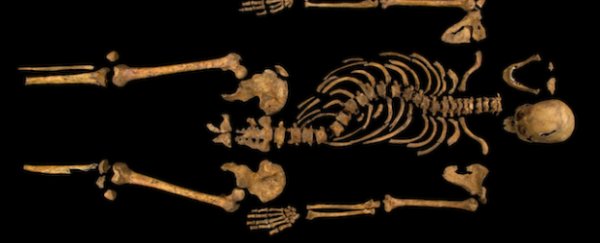Two years ago, a beaten-up skeleton made headlines when it was discovered beneath a parking lot in Leicester in the UK, and was claimed to be the remains of King Richard III.
Although it seemed like an unlikely place for the 15th century royal to end up, the evidence was compelling. The parking lot was built over the remains of an ancient monastery, which is where the King was rumoured to have been buried, the skeleton was the right age and it even had the same scoliosis and physical injuries that Richard III was known for.
But there was still doubt over the identity of the skeleton, formally known as Skeleton 1.
Now, DNA testing has shown with 99.999 percent accuracy (at its most conservative) that the bones really did belong to Richard III, and that, yes, one of the most feared kings of England did end up buried under a parking lot.
The team of international scientists, led by the appropriately named geneticist Turi King, from the University of Leicester, was able to confirm the identify of the skeleton by comparing its DNA and a range of genetic markers to samples taken from living relatives of Richard III.
The strongest evidence came from mitochondrial DNA, which is passed down to children via their mother, and was a genetic match between the remains and the living female-line relatives of Richard III.
However, there wasn't a match between the Y chromosome DNA, which suggests that the male line of Richard III was broken at least once, and the wives of his male relatives most likely participated in extramarital affairs. This discovery puts into question the royal claims of centuries of British monarchs.
But despite the lack of a male line, the statistical evidence proves "beyond reasonable doubt" that Skeleton 1 is indeed the remains of King Richard III. The results are published in Nature Communications.
"Our paper covers all the genetic and genealogical analysis involved in the identification of the remains of Skeleton 1 from the Greyfriars site in Leicester and is the first to draw together all the strands of evidence to come to a conclusion about the identity of those remains," said King in a press release.
"Even with our highly conservative analysis, the evidence is overwhelming that these are indeed the remains of King Richard III, thereby closing an over 500-year-old missing person's case."
This is the oldest forensic case solved to date, and it also provides new insight into what Richard III really looked like.
According to the genetic evidence, King Richard was almost certainly blue-eyed, and he would have probably had blonde hair, at least during childhood.
This is the way he is portrayed in one of the earliest paintings of him, which is kept in the Society of Antiquaries in London.
The team is now looking into sequencing the entire genome of Richard III to find out more about how he died.
Source: Popular Mechanics, EurekAlert
